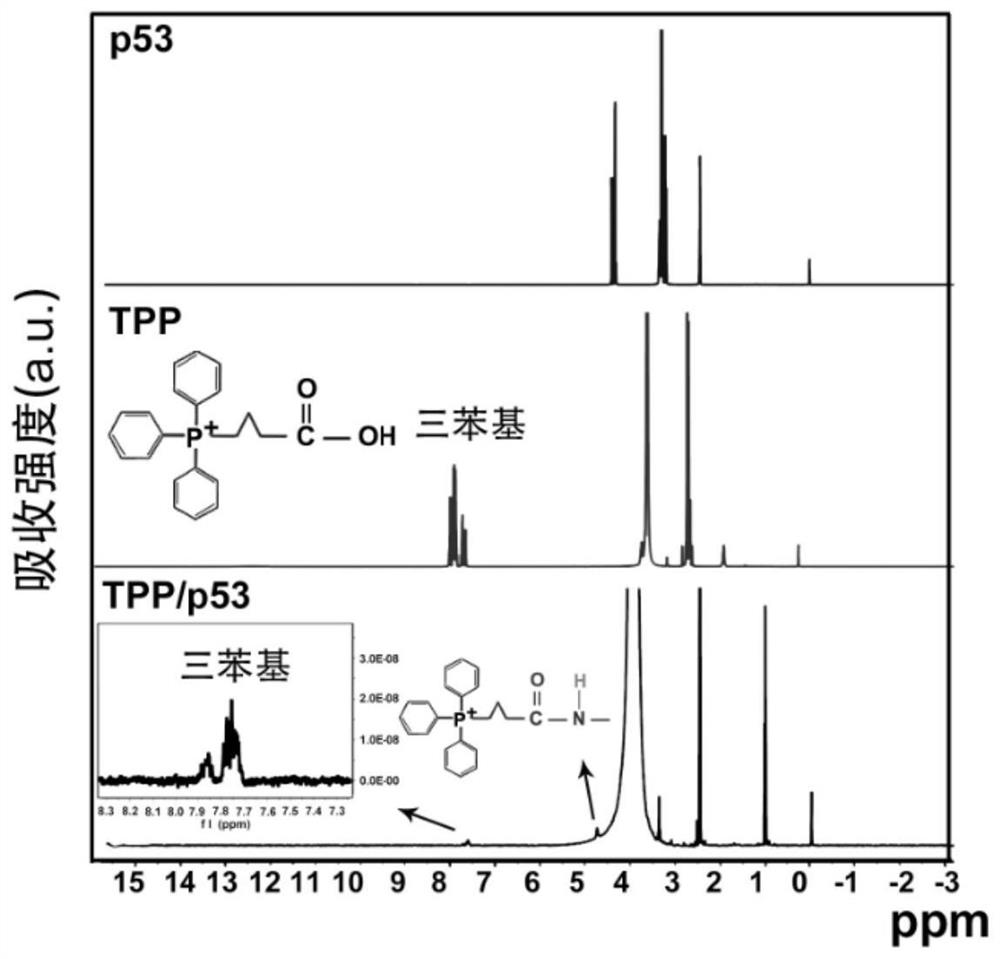Protein nano-drug for cancer targeted therapy and preparation method thereof
A nano-drug, targeted therapy technology, applied in the field of biomedicine, can solve problems such as lack of research, achieve the effect of maintaining integrity, promoting tumor growth and migration, and improving drug delivery efficiency
- Summary
- Abstract
- Description
- Claims
- Application Information
AI Technical Summary
Problems solved by technology
Method used
Image
Examples
Embodiment 1
[0105] Example 1 Preparation of TPP / p53@Exos
[0106] 1. Preparation and characterization of TPP / p53
[0107] 1. Experimental method
[0108] (3-Propylcarboxy)-triphenylphosphine bromide was dissolved in hot phosphate buffered saline (PBS, pH=6.2) to obtain a TPP saturated solution with a concentration of about 0.46 mg / mL; EDC and NHS (20 : 1, n / n), activate the carboxyl group of TPP, and react for about 15 min; add p53 solution (0.6 mg / mL) to the activated TPP solution (~1:1000, n / n), react at room temperature for 2 h, Synthesize TPP / p53; add β-mercaptoethanol to quench EDC (1:1, n / n) for 5min; transfer the reaction solution to a dialysis bag (1000Da), and dialyze it in PBS dialysate for 24h.
[0109] By FT-IR Fourier infrared spectroscopy and 1 The chemical bond changes of TPP / p53 were detected by H-NMR spectroscopy. The secondary structure of recombinant p53 was detected by circular dichroism. Use an ultraviolet spectrophotometer (UV-1800) to scan the maximum absorptio...
Embodiment 2
[0133] Example 2 Cellular uptake and mitochondrial targeting characterization of TPP / p53@Exos
[0134] 1. Experimental method
[0135] The cellular uptake and mitochondria-targeted delivery of the nanodrug delivery system TPP / p53@Exos were observed by immunofluorescence. The exosomes secreted by MCF-7 and SK-BR-3 were purified to prepare TPP / p53@Exos, respectively. MCF-7 and SK-BR-3 cells were treated with two cell-derived TPP / p53@Exos, respectively, at 37°C, 5% CO 2 Incubate in a constant temperature incubator for 2 h; fix cells with pre-cooled 4% paraformaldehyde at room temperature for 15 min; use TBS triethanolamine buffered saline solution to permeate the membrane for 5 min; incubate with CD63 primary antibody (diluted 1:100) to label exosomes , 4°C overnight; use FITC fluorescent secondary antibody (diluted 1:1000) to incubate at room temperature for 1 h; use DAPI staining solution (diluted 1:1000) to incubate cells at room temperature for 10 min to stain cell nuclei; ...
Embodiment 3
[0141] Example 3 Toxicity characterization of TPP / p53@Exos on syngeneic cancer cells
[0142] 1. Experimental method
[0143] (1) CCK-8 assay was used to detect the growth inhibitory effect of TPP / p53@Exos on cancer cells. Follow 1×10 4Cell density MCF-7 (ER+, PR+, HER2-) cells were seeded on 96-well plates and incubated overnight; free p53 protein, MCF-7-derived empty exosome mExos, TPP / p53 recombinant protein and TPP were respectively / p53@mExos nano-drug delivery system (equal p53 molar amount, 600ng / well) acted on MCF-7 cells for 24h; in order to detect the affinity effect of nano-drug delivery system on homologous breast cancer cell lines, p53 mutant breast cancer The cell line SK-BR-3 (ER-, PR-, HER2+) was used as a control, and the same treatment was applied with TPP / p53@mExos; CCK-8 cell viability detection kit working solution was added for incubation, and a microplate reader (ThermoFisher MK3) was used. The absorbance of cells at a wavelength of 450 nm was measure...
PUM
| Property | Measurement | Unit |
|---|---|---|
| Molecular weight | aaaaa | aaaaa |
Abstract
Description
Claims
Application Information
 Login to View More
Login to View More - R&D
- Intellectual Property
- Life Sciences
- Materials
- Tech Scout
- Unparalleled Data Quality
- Higher Quality Content
- 60% Fewer Hallucinations
Browse by: Latest US Patents, China's latest patents, Technical Efficacy Thesaurus, Application Domain, Technology Topic, Popular Technical Reports.
© 2025 PatSnap. All rights reserved.Legal|Privacy policy|Modern Slavery Act Transparency Statement|Sitemap|About US| Contact US: help@patsnap.com



